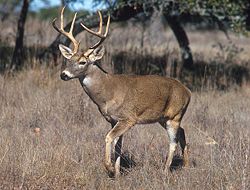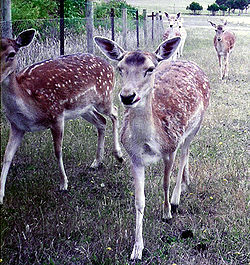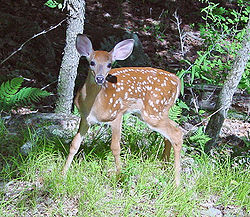Difference between revisions of "Deer" - New World Encyclopedia
Katya Swarts (talk | contribs) (Added article and credit tags) |
Katya Swarts (talk | contribs) |
||
| Line 1: | Line 1: | ||
| − | {{ | + | |
| − | | color = pink | + | {{Taxobox_begin | color = pink | name = Deer}} |
| − | | name = Deer | + | {{Taxobox_image | image = [[image:Deervelvet.jpg|250px]] | caption = }} |
| − | | image = Deervelvet.jpg | + | {{Taxobox_begin_placement | color = pink}} |
| − | | | + | {{Taxobox_regnum_entry | taxon = [[Animal]]ia}} |
| − | | | + | {{Taxobox_phylum_entry | taxon = [[Chordate|Chordata]]}} |
| − | | | + | {{Taxobox_classis_entry | taxon = [[Mammal]]ia}} |
| − | | | + | {{Taxobox_ordo_entry | taxon = [[Artiodactyla]]}} |
| − | | | + | {{Taxobox_subordo_entry | taxon = [[Ruminantia]]}} |
| − | | | + | {{Taxobox_familia_entry | taxon = [[Cervidae]]}}<br/>{{Taxobox authority | author = [[Georg August Goldfuss|Goldfuss]] | date = 1820}} |
| − | | | + | {{Taxobox_end_placement}} |
| − | | | + | {{Taxobox_section_subdivision | color = pink | plural_taxon = Subfamilies}} |
| − | | | ||
| − | | | ||
[[Capreolinae]]<br> | [[Capreolinae]]<br> | ||
[[Cervinae]]<br> | [[Cervinae]]<br> | ||
[[Hydropotinae]]<br> | [[Hydropotinae]]<br> | ||
[[Muntiacinae]] | [[Muntiacinae]] | ||
| − | }} | + | {{Taxobox_end}} |
A '''deer''' is a [[ruminant]] [[mammal]] belonging to the [[family (biology)|family]] '''Cervidae'''. A number of broadly similar animals, from related families within the [[order (biology)|order]] [[Artiodactyla]], are often also called ''deer''. | A '''deer''' is a [[ruminant]] [[mammal]] belonging to the [[family (biology)|family]] '''Cervidae'''. A number of broadly similar animals, from related families within the [[order (biology)|order]] [[Artiodactyla]], are often also called ''deer''. | ||
| Line 129: | Line 127: | ||
{{-}} | {{-}} | ||
| − | + | ||
| − | |||
| − | |||
| − | |||
| − | |||
| − | |||
| − | |||
| − | |||
{{credit|62523143}} | {{credit|62523143}} | ||
[[Category:Life sciences]] | [[Category:Life sciences]] | ||
Revision as of 12:59, 8 July 2006
| Deer | ||||||||||||
|---|---|---|---|---|---|---|---|---|---|---|---|---|
| 250px | ||||||||||||
| Scientific classification | ||||||||||||
| ||||||||||||
| Subfamilies | ||||||||||||
|
Capreolinae |
A deer is a ruminant mammal belonging to the family Cervidae. A number of broadly similar animals, from related families within the order Artiodactyla, are often also called deer.
Depending on the species, male deer are called stags, harts, bucks or bulls, and females are called hinds, does or cows. Young deer are called calves or fawns (not to be confused with fauns, a kind of nature spirit). Hart is an expression for a stag, particularly a Red Deer stag past its fifth year. It is not commonly used, but an example is in Shakespeare's "Romeo and Juliet" when Tybalt refers to the brawling Montagues and Capulets as hartless hinds. "The White Hart" and "The Red Hart" are common English pub names.
Deer are widely distributed, and hunted, with representatives in all continents except Australia, Antarctica, and Africa. Australia does have six introduced species of deer that have established sustainable wild populations from Acclimatisation Society releases in the 19th Century. These are Fallow Deer, Red Deer, Sambar Deer, Hog Deer, Rusa deer, and Chital Deer[1]. Although exotic to the continent, environmental factors restrict their ranges to habitable patches, thereby preventing any one species from becoming a serious pest. Red Deer introduced into New Zealand in early 1900s (a gift from United States President Theodore Roosevelt) have been largely domesticated in deer farms since the late 1960s and are common farm animals there now.
Deer differ from other ruminants in that they have antlers instead of horns. Antlers are bony growths that develop each year (usually in summer) and, in general, it is only male deer that develop them (although there are exceptions). A young buck's first pair of antlers grow from two tiny bumps on their head that they have had from birth. The antlers grow wrapped in a thick layer of velvet and remain that way for one month, until the bone inside is hard; later the velvet is shed. During the mating season, bucks use their antlers to fight one another for the opportunity to attract mates in a given herd. The two bucks circle each other, bend back their legs, lower their heads, and charge.
A doe generally has one or two fawns at a time (triplets, while not unusual, are much more infrequent). The gestation period is anywhere between 160 days (just over 5 months) in the musk deer to ten months for the roe deer. Most fawns are born with their fur covered with white spots, though they lose their spots once they get older (excluding the Fallow Deer who keeps its spots for life). In the first twenty minutes of a fawn's life, the fawn begins to take its first steps. Its mother licks it clean until it is almost free of scent, so predators will not find it. Its mother leaves often, and the fawn does not like to be left behind. Sometimes its mother must gently push it down with her foot. The fawn stays hidden in the grass for one week until it is strong enough to walk with its mother. After two days, a fawn is able to walk, and by three weeks it can run and jump. The fawn and its mother stay together for about one year. They then go their separate ways. A male usually never sees his mother again, but females sometimes come back with their own fawns and form small herds.
Deer generally have lithe, compact bodies and long, powerful legs suited for rugged woodland terrain. Deer are also excellent swimmers. Their lower cheek teeth have crescent ridges of enamel, which enable them to grind a wide variety of vegetation. Deer are ruminants or cud-chewers and have a four-chambered stomach. Nearly all deer have a facial gland in front of each eye. The gland contains a strongly scented substance called pheromone, used to mark its home range. Bucks of a wide range of species open these glands wide when angry or excited. Except for the musk deer, all deer have a liver without a gallbladder. The musk deer, along with the Chinese water deer also differ from other species in that they have no antlers and bear upper canines developed into tusks.
There are about 34 species of deer worldwide, divided into two broad groups: the old world group includes the subfamilies Muntiacinae and Cervinae; the new world deer the subfamilies Hydropotinae and Capreolinae. Note that the terms indicate the origin of the groups, not their modern distribution: the Water Deer, for example, is a new world species but is found only in China and Korea.
It is thought that the new world group evolved about 5 million years ago in the forests of North America and Siberia, the old world deer in Asia.
Genera and species of deer
The family Cervidae is organized as follows:
- Subfamily Hydropotinae
- Chinese Water Deer (Hydroptes inermis)
- Subfamily Muntiacinae (mostly Muntjacs)
- Bornean Yellow Muntjac (Muntiacus atherodes)
- Black Muntjac (Muntiacus crinifrons)
- Fea's Muntjac (Muntiacus feae)
- Gongshan Muntjac (Muntiacus gongshanensis)
- Indian Muntjac (Muntiacus muntjac)
- Leaf Muntjac (Muntiacus putaoensis)
- Reeves' Muntjac (Muntiacus reevesi)
- Truong Son Muntjac (Muntiacus trungsonensis)
- Giant Muntjac (Muntiacus vuquangensis)
- Tufted Deer (Elaphodus cephalophus)
- Subfamily Cervinae
- White-lipped Deer or Thorold's Deer (Cervus albirostris)
- Philippine Spotted Deer or Visayan Spotted Deer (Cervus alfredi)
- Barasingha (Cervus duvaucelii)
- Red Deer (Cervus elaphus; called elk or wapiti in America)
- Thamin (Cervus eldii)
- Philippine Sambar or Philippine Brown Deer (Cervus mariannus)
- Sika Deer (Cervus nippon)
- Schomburgk's Deer (Cervus schomburgki) (extinct, 1938)
- Sunda Sambar or Rusa deer (Cervus timorensis)
- Sambar Deer (Cervus unicolor)
- Chital (Axis axis)
- Calamian Deer (Axis calamianensis)
- Bawean Deer (Axis kuhlii)
- Hog Deer (Axis porcinus)
- Père David's Deer (Elaphurus davidianus)
- Fallow Deer (Dama dama)
- Persian Fallow Deer (Dama mesopotamica)
- Subfamily Capreolinae
- Roe Deer (Capreolus capreolus)
- Moose (Alces alces)
- Mule Deer (Odocoileus hemionus)
- White-tailed Deer (Odocoileus virginianus)
- Pampas Deer (Ozotoceros bezoarticus)
- Red Brocket (Mazama americana)
- Merioa Brocket (Mazama bricenii)
- Dwarf Brocket (Mazama chunyi)
- Grey Brocket (Mazama gouazoubira)
- Pygmy Brocket (Mazama nana)
- Yucatan Brown Brocket (Mazama pandora)
- Little Red Brocket (Mazama rufina)
- Northern Pudu (Pudu mephistophiles)
- Southern Pudu (Pudu pudu)
- Marsh Deer (Blastocerus dichotomus)
- Peruvian Guemal or North Andean Deer (Hippocamelus antisensis)
- Chilean Huemul or South Andean Deer (Hippocamelus bisulcus)
- Caribou/Reindeer (Rangifer tarandus)
Deer are selective feeders. They feed on leaves. They have small, unspecialised stomachs by herbivore standards, and high nutrition requirements: ingesting sufficient minerals to grow a new pair of antlers every year is a significant task. Rather than attempt to digest vast quantities of low-grade, fibrous food as, for example, sheep and cattle do, deer select easily digestible shoots, young leaves, fresh grasses, soft twigs, fruit, fungi, and lichens.
Deer have long had economic significance to humans. While they are generally not as easily domesticated as sheep, goats, pigs, and even cattle, the association between people and deer is very old. Deer meat, for which they are hunted and farmed, is called venison.
Musk, which comes from the gland on the abdomen of musk deer, is used in medicenes and perfumes. Deerskin is used for shoes, boots, and gloves, and antlers are made into buttons and knife handles. The Saami of Scandinavia and the Kola Peninsula of Russia and other nomadic peoples of northern Asia used reindeer for food, clothing, and transport. The caribou is not domesticated or herded as is the case in Europe but is important to the Inuit. Most commercial vension in the United States is imported from New Zealand. Deer were originally brought to New Zealand by European settlers, and the deer population rose rapidly. This caused great environmental damage and was controlled by hunting and poisoning until the concept of deer farming in the 1960s. Deer farms in New Zealand number more than 3,500, with more than 400,000 deer in all.
Hybrid deer
In Origin of Species (1859) Charles Darwin wrote "Although I do not know of any thoroughly well-authenticated cases of perfectly fertile hybrid animals, I have some reason to believe that the hybrids from Cervulus vaginalis and Reevesii [...] are perfectly fertile." These two varieties of muntjac are currently considered the same species.
A number of deer hybrids are bred to improve meat yield in farmed deer. Once considered separate species because of the great differences between them, American Elk (or Wapiti) and Red Deer from the Old World can produce fertile offspring, and are now considered one species. (The European Elk is a different species and is known as moose in North America.) The hybrids are about 30% more efficient in producing antler by comparing velvet to body weight. Wapiti have been introduced into some European Red Deer herds to improve the Red Deer type, but not always with the intended improvement.
In New Zealand, where deer are introduced species, there are hybrid zones between Red Deer and North American Wapiti populations and also between Red Deer and Sika Deer populations. In New Zealand Red Deer have been artificially hybridized with Pere David Deer in order to create a farmed deer which gives birth in spring. The initial hybrids were created by artificial insemination and back-crossed to Red Deer.
In Canada, the farming of European Red Deer and Red Deer hybrids is considered a threat to native Wapiti. In Britain, the introduced Sika Deer is considered a threat to native Red Deer. Initial Sika Deer/Red Deer hybrids occur when young Sika stags expand their range into established red deer areas and have no Sika hinds to mate with. They mate instead with young Red hinds and produce fertile hybrids. These hybrids mate with either Sika or Red Deer (depending which species is prevalent in the area), resulting in mongrelization. Many of the Sika Deer which escaped from British parks were probably already hybrids for this reason.
In captivity, Mule Deer have been mated to White-tail Deer. Both male Mule Deer/female White-tail and male White-tail/female Mule deer matings have produced hybrids. Less than 50% of the hybrid fawns survived their first few months. Hybrids have been reported in the wild but are disadvantaged because they don't properly inherit survival strategies. Mule Deer move with bounding leaps (all 4 hooves hit the ground at once, also called "stotting") to escape predators. Stotting is so specialized that only 100% genetically pure Mule Deer seem able to do it. In captive hybrids, even a one-eighth White-tail/seven-eighths Mule Deer hybrid has an erratic escape behaviour and would be unlikely to survive to breeding age. Hybrids do survive on game ranches where both species are kept and where predators are controlled by man.
Fictional deer
- For role of deer in mythology, see deer in mythology.
- In Christmas lore (such as in the narrative poem "A Visit from St. Nicholas"), reindeer are believed to pull the sleigh of Santa Claus.
- One famous fictional deer is Bambi. Contrary to what most people believe, in the Disney movie Bambi, he is a white-tailed deer, while in Felix Salten's original book Bambi, A Life in the Woods, he is a roe deer.
- In The Lion, the Witch and the Wardrobe, a white stag, said to grant one wish to the one who catches him, misleads the Pevensie children in the forest. Lost, they stumble back through the wardrobe to return to our world, ending their adventure.
- Saint Hubertus saw a stag with a crucifix between its antlers while hunting on Good Friday and was converted to Christianity by the vision.
- In Harry Potter and the Prisoner of Azkaban, the Patronus Charm that Harry Potter conjures up to scare away the Dementors is a silver stag. James Potter, Harry's father, had an Animagus form as a stag.
- On the television series Angel, one episode depicts the hart as the last of three animals symbolically representing the evil law firm of Wolfram & Hart.
- In one of the stories of Baron Munchhausen, the baron encounters a stag while eating cherries and without ammunition. He fires the cherry-pits at the stag with his musket, but it escapes. The next year, the baron encounters a stag with a cherry tree growing from its head; presumably this is the animal he had shot at the previous year.
- A Samurai warrior named Honda Tadakatsu famously adorned deer antlers on his helmet.
- Deer has been a subject in Chinese painting numerous times as a tranquility symbol.
Credits
New World Encyclopedia writers and editors rewrote and completed the Wikipedia article in accordance with New World Encyclopedia standards. This article abides by terms of the Creative Commons CC-by-sa 3.0 License (CC-by-sa), which may be used and disseminated with proper attribution. Credit is due under the terms of this license that can reference both the New World Encyclopedia contributors and the selfless volunteer contributors of the Wikimedia Foundation. To cite this article click here for a list of acceptable citing formats.The history of earlier contributions by wikipedians is accessible to researchers here:
The history of this article since it was imported to New World Encyclopedia:
Note: Some restrictions may apply to use of individual images which are separately licensed.


